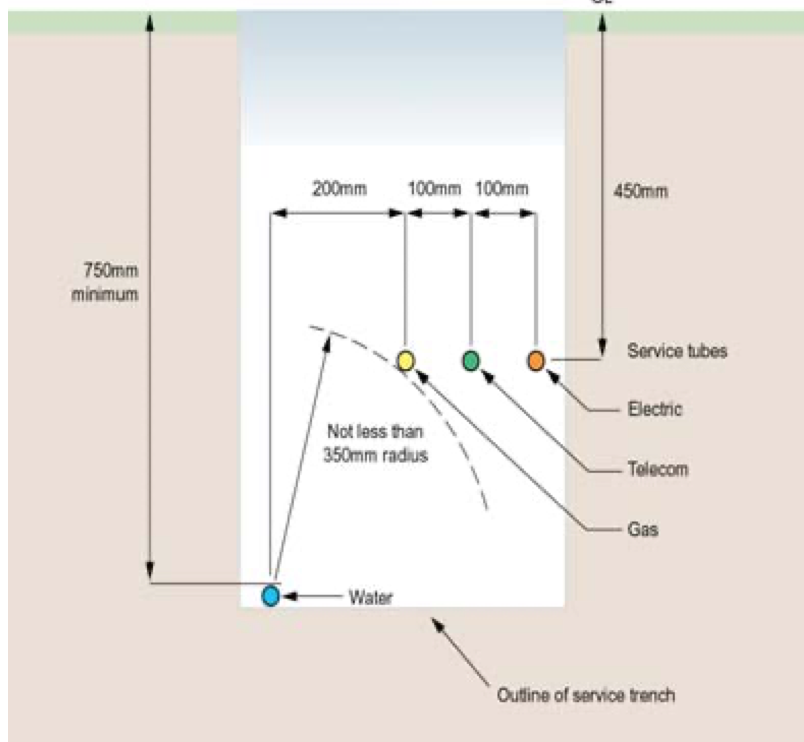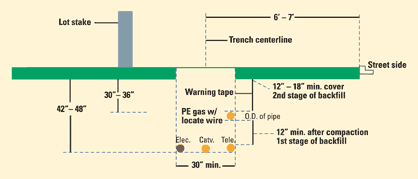Yes, gas and electric can be in the same trench. Gas and electric services are often installed in a joint trench, which may also contain lines for other services like telephone and cable.
Although it is possible to dig a trench yourself, it is recommended to use a licensed contractor for safety reasons. This ensures that the installation is done correctly and safely. It is not against code for gas and electric to be in the same trench, and in fact, it is common practice for utilities to run them together.
However, there are guidelines and regulations that must be followed to ensure the safety of the installation. We will discuss the rules and best practices for installing gas and electric in the same trench.
Introduction To Trench Sharing
When it comes to underground utility installation, trench sharing is a common practice that involves placing gas and electric lines in the same trench. This method offers several benefits but also raises some concerns that need to be carefully addressed. Understanding the advantages and potential challenges of trench sharing is crucial for ensuring safe and efficient utility installations.
Benefits Of Shared Trenching
Shared trenching for gas and electric lines presents several advantages:
- Cost savings on excavation and backfilling
- Reduced environmental impact due to minimized disturbance
- Optimized land use by utilizing a single trench for multiple utilities
- Streamlined coordination and project management
Common Concerns With Shared Trenching
Despite its benefits, shared trenching also raises common concerns that must be carefully addressed:
- Risk of interference between gas and electric lines
- Potential safety hazards during installation and maintenance
- Regulatory compliance and code adherence for joint trenching
- Requirement for proper insulation and separation methods
Legal And Code Considerations
According to the National Electric Code, gas and electric lines can be installed in the same trench, as long as they are properly separated by a minimum of 12 inches horizontally or 18 inches vertically. However, it is recommended to hire a licensed contractor to ensure safe and compliant installation.
Understanding Local Regulations
When considering the installation of gas and electric lines in the same trench, it’s crucial to understand the local regulations governing such practices. Local authorities often have specific requirements and restrictions regarding the co-placement of these utilities. These regulations are put in place to ensure the safety and integrity of the infrastructure.
National Electrical Code Guidelines
The National Electrical Code (NEC) provides comprehensive guidelines and standards for the installation of electrical systems, including the placement of electrical lines in proximity to other utilities such as gas lines. Adhering to NEC guidelines is essential to ensure compliance with national standards and to guarantee the safety and functionality of the installed systems.
Planning For Shared Trenches
It is possible to have gas and electric in the same trench, but it is important to follow proper safety measures and codes. It is recommended to use a licensed contractor for installation and to ensure proper separation distance between the two utilities.
Importance Of Professional Consultation
When it comes to planning for shared trenches that accommodate both gas and electric lines, it is crucial to seek professional consultation. Professional contractors have the expertise and knowledge to ensure that the installation meets all safety standards and regulations. They can evaluate the site and provide guidance on the best practices for designing a joint trench layout.
Designing A Joint Trench Layout
Designing a joint trench layout involves careful consideration of various factors. The distance between the gas and electric lines, as well as the depth and width of the trench, must be determined to prevent any interference or damage. This is where professional consultation becomes essential, as they can assess the specific requirements of the project and design a layout that ensures the safe coexistence of both utilities.
One important aspect of designing a joint trench layout is maintaining the required separation distance between the gas and electric lines. This distance may vary depending on local regulations and safety standards. By adhering to these guidelines, potential risks and hazards can be minimized.
Additionally, the depth and width of the trench should be carefully planned to accommodate both the gas and electric lines effectively. Proper spacing and positioning can prevent any accidental contact or damage, ensuring the longevity and reliability of the utilities.
Overall, designing a joint trench layout requires expertise and precision. It is crucial to consult with professionals who can provide the necessary guidance to ensure a safe and efficient installation.
Safety First: Gas And Electric Proximity
When it comes to burying gas and electric lines, one common question arises: can gas and electric be in the same trench? The answer is yes, but it is important to prioritize safety when considering the proximity of these two utilities. In this article, we will explore the minimum separation requirements, the use of protective barriers and warnings, and why it is crucial to adhere to these guidelines.
Minimum Separation Requirements
When burying gas and electric lines in the same trench, there are specific minimum separation requirements that need to be followed. These requirements vary depending on local building codes and regulations, but typically, there should be a minimum distance of 12 inches between the gas and electric lines. This distance helps to minimize the risk of any potential interactions or accidents between the two utilities.
It is essential to consult with a licensed contractor or your local utility company to ensure you are meeting the minimum separation requirements specific to your area. They can provide you with the necessary guidance and information to ensure a safe and compliant installation.
Protective Barriers And Warnings
In addition to maintaining the minimum separation requirements, it is also important to use protective barriers and provide clear warnings when gas and electric lines are in the same trench. These precautions help to prevent accidental damage or interference with the utilities during construction or any future maintenance work.
Protective barriers can include physical barriers, such as PVC conduit or metal piping, that act as a barrier between the gas and electric lines. These barriers provide an extra layer of protection and can help prevent accidental contact or damage to either utility.
Clear warnings should also be displayed to indicate the presence of both gas and electric lines in the trench. These warnings can include signs, markers, or caution tape to alert workers and anyone in the vicinity to exercise caution and avoid any accidental damage to the utilities.
When burying gas and electric lines in the same trench, safety should always be the top priority. By adhering to the minimum separation requirements and using protective barriers and warnings, you can ensure a safe and compliant installation. Remember to consult with professionals in your area to ensure you are following the specific guidelines and regulations set forth by your local authorities.
Digging The Trench
Gas and electric services can be installed in the same trench, along with other utility lines like telephone and cable. It is recommended to hire a licensed contractor for trenching projects, although it is not against code for gas and electric lines to be in the same trench.
Tools And Techniques
Digging a trench for gas and electric lines requires specific tools and techniques. Excavation equipment like backhoes, trenchers, and shovels are commonly used for digging trenches. However, using a trencher for gas and electric lines is not recommended because it can damage the lines. Instead, manual excavation with shovels is the preferred method for digging trenches for gas and electric lines.
Depth And Width Specifications
Digging a trench for gas and electric lines requires precision. The depth and width specifications are important to ensure the safety and reliability of the lines. The minimum depth for gas lines is usually 18 inches, while electric lines require a minimum depth of 24 inches. The width of the trench should be wide enough to accommodate the lines and allow for a minimum of 6 inches of clearance on either side of the lines.
It is important to note that the depth and width specifications may vary depending on the location and the local building codes. Therefore, it is recommended to consult with a licensed contractor or the local building department before digging a trench for gas and electric lines.
In conclusion, it is possible to install gas and electric lines in the same trench. However, it requires careful planning, precision, and adherence to the local building codes and regulations. Using the right tools and techniques, and following the depth and width specifications are crucial for the safety and reliability of the lines.
Installation Procedures
When installing gas and electric lines, it is possible for them to be placed in the same trench. However, it is crucial to ensure proper safety measures and compliance with regulations. Hiring a licensed contractor is recommended to handle the installation of gas and electric lines in a joint trench.
Laying Electrical Conduits
When installing gas and electric lines in the same trench, it is important to follow proper installation procedures to ensure safety and compliance with building codes. For laying electrical conduits, the following steps should be taken:
- Excavate the trench to the required depth and width.
- Install a layer of sand at the bottom of the trench to protect the conduit.
- Place the electrical conduit in the trench, ensuring it is straight and level.
- Secure the conduit to prevent it from shifting or being damaged during backfilling.
- Install warning tape above the conduit to indicate its location.
- Backfill the trench, ensuring that the conduit is not damaged or crushed.
- Install a conduit sleeve at the point where the electrical conduit enters or exits the gas line trench, to prevent any contact or interference between the two.
Installing Gas Lines
For installing gas lines in the same trench as electrical conduits, the following steps should be taken:
- Determine the location of the gas line and ensure that it complies with all building codes and regulations.
- Excavate the trench to the required depth and width.
- Install a layer of sand at the bottom of the trench to protect the gas line.
- Place the gas line in the trench, ensuring it is straight and level.
- Secure the gas line to prevent it from shifting or being damaged during backfilling.
- Install warning tape above the gas line to indicate its location.
- Backfill the trench, ensuring that the gas line is not damaged or crushed.
- Install a gas line sleeve at the point where the gas line enters or exits the electrical conduit trench, to prevent any contact or interference between the two.
- Conduct a pressure test to ensure that the gas line is properly installed and does not leak.
It is important to note that the distance between the electrical conduit and gas line must be at least 12 inches to prevent any interference or damage to either line. Additionally, it is recommended to use a licensed contractor for the installation of gas and electric lines in the same trench to ensure compliance with all building codes and regulations.
Inspection And Testing
When it comes to trenching for gas and electric lines, it’s essential to ensure proper installation and safety. Both gas and electric can be in the same trench, but it’s crucial to follow regulations and maintain a safe distance between the two to prevent any potential hazards.
Professional guidance from a licensed contractor is recommended for this type of installation to ensure compliance and safety.
Gas Pressure Test Gauge
When it comes to the inspection and testing of gas and electric lines in the same trench, one important aspect to consider is the gas pressure test gauge. This gauge is used to measure the pressure of the gas line and ensure that it is within the acceptable range. During the inspection process, the gauge is connected to the gas line, and the pressure is measured. If the pressure falls within the specified range, it indicates that the gas line is functioning properly.
Electrical System Checks
Another crucial aspect of the inspection and testing process is conducting checks on the electrical system. This involves ensuring that the electrical wiring and components are installed correctly and in compliance with the necessary safety standards. The inspection includes checking for any loose connections, exposed wires, or other potential hazards that could pose a risk of electrical shock or fire.
During the electrical system checks, it is important to verify that the electrical wiring is properly insulated and protected from any potential damage. This includes ensuring that the wires are not in direct contact with the gas line or any other conductive material that could cause a short circuit or electrical malfunction.
To ensure the safety and proper functioning of both the gas and electric systems, it is essential to adhere to the necessary inspection and testing procedures. By conducting regular checks and following the appropriate guidelines, you can maintain the integrity of both systems and ensure the safety of your property and its occupants.
In conclusion, the inspection and testing of gas and electric lines in the same trench require careful attention to detail. By using a gas pressure test gauge and conducting thorough electrical system checks, you can ensure the proper functioning and safety of both systems. Remember to always consult with a licensed contractor or professional when performing these inspections to ensure compliance with local regulations and industry standards.
Maintenance And Accessibility
Gas and electric can be placed in the same trench, but there are specific guidelines to ensure safety and accessibility for maintenance. It’s crucial to maintain a safe distance between the two to prevent any potential hazards. Proper installation by a licensed contractor is recommended to ensure compliance with regulations.
Future Access For Repairs
When it comes to the maintenance and accessibility of gas and electric lines in the same trench, one important consideration is future access for repairs. While it is not against code for both gas and electric lines to be in the same trench, it is crucial to ensure that proper measures are taken to allow for easy access in case of any repairs or maintenance work.
Monitoring And Upkeep
Monitoring and upkeep are essential aspects of maintaining the safety and efficiency of gas and electric lines in the same trench. Regular monitoring helps identify any potential issues or leaks that may arise over time. By conducting routine inspections and maintenance, you can prevent any hazardous situations and ensure the smooth functioning of both gas and electric lines.
To ensure effective monitoring and upkeep, here are some key practices to consider:
- Regular Inspections: Schedule periodic inspections of the trench to identify any signs of wear and tear, corrosion, or damage to the gas and electric lines. This can help address any potential issues before they escalate.
- Leak Detection: Utilize advanced leak detection technology to promptly identify and address any gas or electric leaks. Early detection can prevent accidents and minimize potential damage.
- Proper Ventilation: Ensure adequate ventilation in the trench to prevent the accumulation of dangerous gases or fumes. Proper ventilation is crucial for the safety of maintenance personnel and the overall integrity of the lines.
- Regular Maintenance: Implement a proactive maintenance schedule to keep both the gas and electric lines in optimal condition. This may include cleaning, lubrication, and replacement of worn-out components.
- Documentation: Maintain detailed records of all maintenance activities, inspections, and repairs. This documentation can serve as a valuable reference for future maintenance work and ensure compliance with regulatory requirements.
By adhering to these practices, you can ensure the longevity and reliability of gas and electric lines in the same trench while prioritizing safety and accessibility for future repairs. Remember, it is always recommended to consult with licensed contractors and follow local regulations and guidelines for trenching and utility installations.
Common Mistakes To Avoid
When installing gas and electric lines in the same trench, it’s crucial to avoid common mistakes that can lead to safety hazards and costly repairs down the line. By being aware of these potential pitfalls, you can ensure that the installation is done correctly and meets all necessary safety standards.
Incorrect Spacing
One common mistake when installing gas and electric lines in the same trench is improper spacing between the two types of lines. It’s essential to maintain the required distance between the gas and electric lines to prevent any potential interference or damage. Failure to adhere to proper spacing guidelines can lead to safety hazards and regulatory violations.
Inadequate Compaction
Another critical mistake to avoid is inadequate compaction of the trench after the installation of gas and electric lines. Proper compaction is essential to ensure the stability and integrity of the lines. Inadequate compaction can result in shifting or settling of the lines, leading to potential damage and safety risks over time.

Credit: forum.buildhub.org.uk
Additional Utilities In The Trench
When installing gas and electric lines, it’s common to consider including additional utilities in the same trench. However, there are specific considerations and guidelines to follow when incorporating other services into the trench alongside gas and electric lines.
Telephone And Cable Considerations
When trenching for gas and electric lines, it’s important to consider the inclusion of telephone and cable lines in the same trench. However, it’s crucial to adhere to the regulations and guidelines set forth by relevant authorities to ensure the safety and functionality of all utilities involved.
Water Lines: A Separate Matter
While gas and electric lines can be placed in the same trench, the inclusion of water lines requires a separate approach. Water lines have their own set of requirements and regulations that must be followed, and typically should be installed separately from gas and electric lines to avoid potential conflicts and ensure compliance with safety standards.
Diy Vs Professional Installation
When it comes to installing gas and electric lines in the same trench, the choice between DIY and professional installation is a crucial decision. Each option has its own set of considerations and implications that can impact the safety and efficiency of the installation.
Assessing Technical Ability
Before embarking on a project to install gas and electric lines in the same trench, it’s essential to assess your technical ability. This involves evaluating your knowledge and skills in handling gas and electrical components, understanding local building codes and regulations, and implementing proper safety measures.
When To Hire A Licensed Contractor
If you lack the necessary technical expertise, experience, or confidence to carry out the installation safely and effectively, hiring a licensed contractor is highly recommended. Additionally, if the project involves complex or extensive trenching, or if it requires coordination with utility providers, enlisting the services of a professional can ensure compliance with regulations and standards.

Credit: landdevelopment101.com
Conclusion: Best Practices For Joint Trenching
When it comes to joint trenching for gas and electric lines, it is important to follow best practices to ensure safety and compliance with regulations. By adhering to these guidelines, you can minimize risks and potential hazards. Let’s recap the key points to keep in mind and conclude with some final thoughts on safe digging.
Recap Of Key Points
Here is a summary of the key points to remember when considering joint trenching for gas and electric lines:
- Gas and electric services can be installed in the same trench, along with other utility lines like telephone and cable.
- Pacific Gas and Electric Company (PG&E) recommends using a licensed contractor for trenching projects.
- Ensure a safe distance between electrical wires and gas lines to prevent potential hazards.
- Consider the use of conduit for electrical wiring to provide added protection.
- Follow local codes and regulations to ensure compliance and safety.
Final Thoughts On Safe Digging
Safe digging practices are crucial when working with joint trenching for gas and electric lines. By following these best practices, you can minimize the risk of accidents, ensure compliance with regulations, and maintain the integrity of the utility lines. Remember to always consult with professionals and adhere to local codes to guarantee a safe and successful trenching project.

Credit: www.centerpointenergy.com
Frequently Asked Questions
What Utilities Can Be Buried In Same Trench?
Gas and electric services can be buried in the same trench. This joint trench may also include lines for telephone and cable services. It is recommended to hire a licensed contractor for trenching work. There is no safe way to separate all buried utilities, as boring machines often push in miles of underground lines.
However, most utility companies allow gas and electric lines to be in the same trench.
How Close Can Electrical Wire Be To Gas Line?
Electrical wires can be placed in close proximity to gas lines, but it is important to follow safety guidelines. It is recommended to consult a licensed contractor and adhere to local building codes to ensure proper installation and safety measures are followed.
Can You Bury Gas Line With Electrical?
Yes, gas and electrical lines can be buried in the same trench. In fact, it is common for gas and electric services to be installed in a joint trench, along with other services like telephone and cable. However, it is recommended to use a licensed contractor for digging the trench and installing the lines.
It is also important to maintain a safe distance between the gas and electrical lines.
Can You Run An Electric Cable Next To A Gas Pipe?
It is not against code for electric cables and gas pipes to be in the same trench. In fact, gas and electric services are often installed in a joint trench. However, it is recommended to use a licensed contractor and follow guidelines set by utility companies like Pacific Gas and Electric Company (PG&E).
The distance between them should be considered and caution should be exercised during installation.
Can Gas And Electric Lines Be Installed In The Same Trench?
Yes, gas and electric lines can be installed in the same trench to optimize space and reduce excavation work.
Conclusion
It is possible for gas and electric lines to be placed in the same trench. Many utility companies often run them together, ensuring proper separation is maintained. However, it is important to follow safety guidelines and regulations when installing these lines.
Hiring a licensed contractor is recommended to ensure a professional and compliant installation. By adhering to these guidelines, you can safely and efficiently install gas and electric lines in the same trench.




